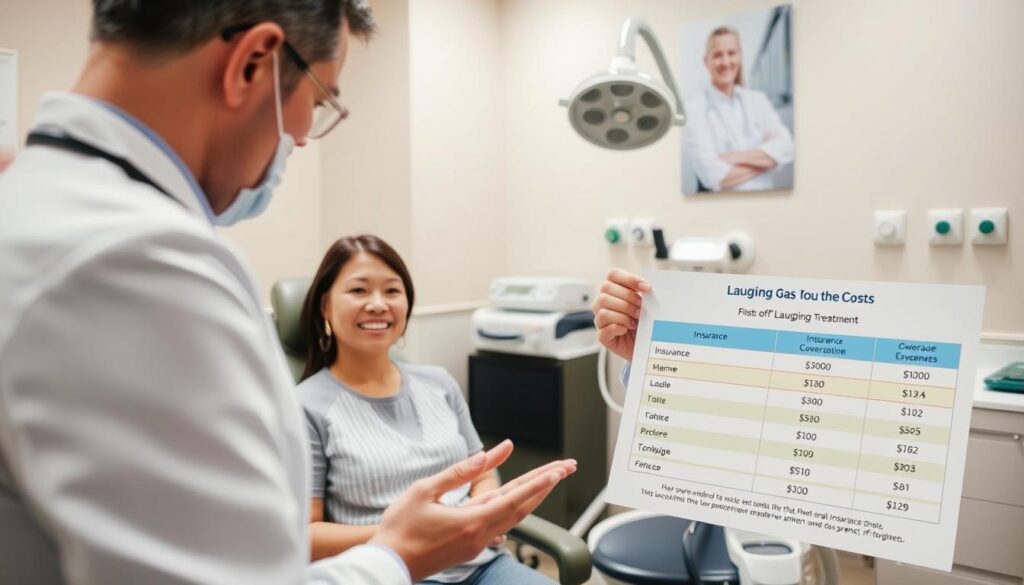Many patients find dental procedures scary. Laughing gas, or nitrous oxide, helps make them more comfortable. But, what factors influence its cost when you have insurance?
The cost of laughing gas with insurance changes based on several things. These include the dental provider, where you are, and your insurance.
Key Takeaways
- The cost of laughing gas varies by dental provider.
- Insurance coverage plays a significant role in determining out-of-pocket costs.
- Location can impact the overall cost of laughing gas.
- Patients should review their insurance policies to understand what is covered.
- Additional factors, such as procedure complexity, may influence costs.
Understanding Laughing Gas and Its Use in Dentistry
Laughing gas, or nitrous oxide, has been used in dentistry for over a century. It’s a simple way to help patients feel less anxious during dental visits.
What is Laughing Gas?
Laughing gas is a colorless gas with a sweet smell. It’s used in dental offices to help patients relax. The gas is given through a mask that fits over the nose, making patients calm without making them sleep.
Benefits of Using Laughing Gas
Laughing gas has many benefits in dentistry. It’s safe and effective for managing anxiety, especially for long or complex procedures. The dentist can adjust the amount of gas to the right level of relaxation.
Another great thing is that it works quickly. Patients can go back to their normal activities soon after. It’s also good for many patients, including kids and those with certain health issues.
Common Dental Procedures That Use Laughing Gas
Laughing gas is used for many dental procedures. It helps make dental visits more comfortable for anxious patients.
Some common uses include:
- Dental fillings
- Tooth extractions
- Root canal treatments
- Dental implant placements
Knowing about laughing gas helps patients understand how to manage dental anxiety. It makes them more informed about their dental care options.
The Cost of Laughing Gas Without Insurance
Laughing gas is a common sedation in dentistry. It has a price that changes a lot in the U.S. For those without insurance, knowing these costs is key for planning dental care.
Average Prices Across the U.S.
The cost of laughing gas varies a lot. It can be between $50 to $200 or more per visit. This depends on where you are and the dental practice.
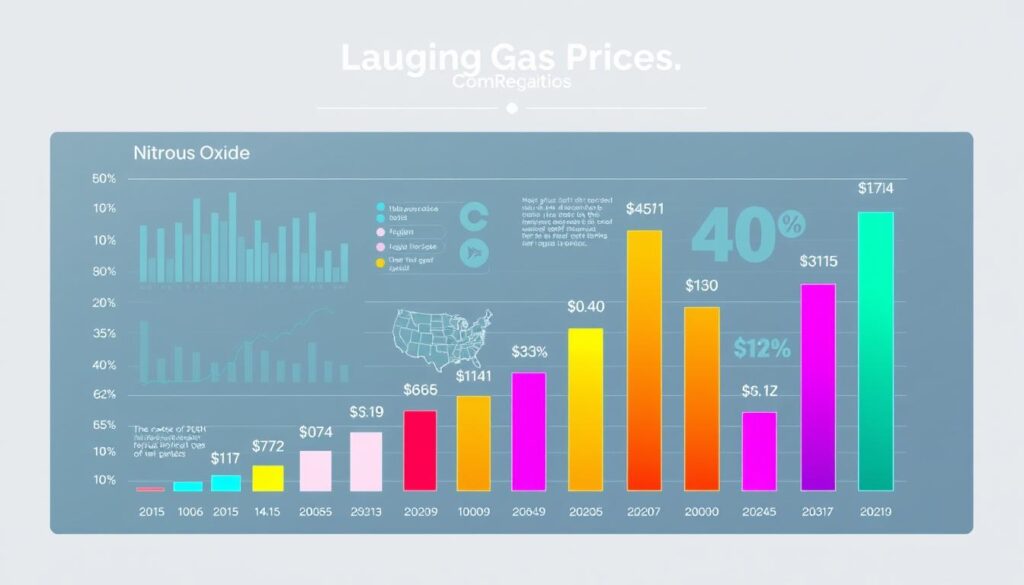
Factors Affecting Pricing
Several things affect the cost of laughing gas:
- The location of the dental practice
- The dentist’s level of experience
- The type of dental procedure being performed
- The duration of the procedure
These factors can change the cost a lot. So, the cost can vary from one visit to another.
Comparing Laughing Gas Costs With Other Sedation Options
Laughing gas is just one of many sedation options in dentistry. Here’s a comparison of its costs with other common sedation methods:
| Sedation Method | Average Cost | Duration of Effect |
|---|---|---|
| Laughing Gas | $50-$200 | During procedure |
| Oral Sedation | $200-$500 | Several hours |
| IV Sedation | $300-$600 | Several hours |
Knowing these costs and options helps patients make better choices for their dental care.
How Insurance Affects the Cost of Laughing Gas
Dental insurance is key in figuring out how much you’ll pay for laughing gas at the dentist. Knowing what your insurance covers can help lower your costs.
Overview of Dental Insurance Coverage
Dental insurance plans differ in what they cover for sedation dentistry, like laughing gas. Some might pay for part of it, while others might not cover it at all. Insurance companies usually group laughing gas with sedation dentistry or list it separately, which affects coverage.
It’s crucial to check your insurance policy to see how laughing gas is classified and covered. This info helps you get ready for the costs of your dental care.
What to Check in Your Insurance Policy
When looking at your dental insurance policy, several important points can affect your coverage for laughing gas:
- Type of Plan: Different plans (like PPO or HMO) offer different levels of coverage for sedation dentistry.
- Coverage Percentage: Find out what percentage of the laughing gas cost your insurance will cover.
- Deductibles and Co-pays: Know your out-of-pocket costs, including deductibles and co-pays.
- Pre-approval Requirements: Some procedures need pre-approval; see if this is true for laughing gas.
Limitations and Exclusions
Insurance policies often have limits and exclusions that can impact your coverage for laughing gas. Common limits include:
- Annual or lifetime maximums on sedation dentistry coverage.
- Exclusions for certain procedures or diagnoses.
- Waiting periods before coverage starts.
Knowing these limits helps you plan your dental care and budget better.
Typical Coverage for Laughing Gas
The amount of laughing gas coverage varies by insurance plan. Different providers offer different levels of coverage for dental procedures.
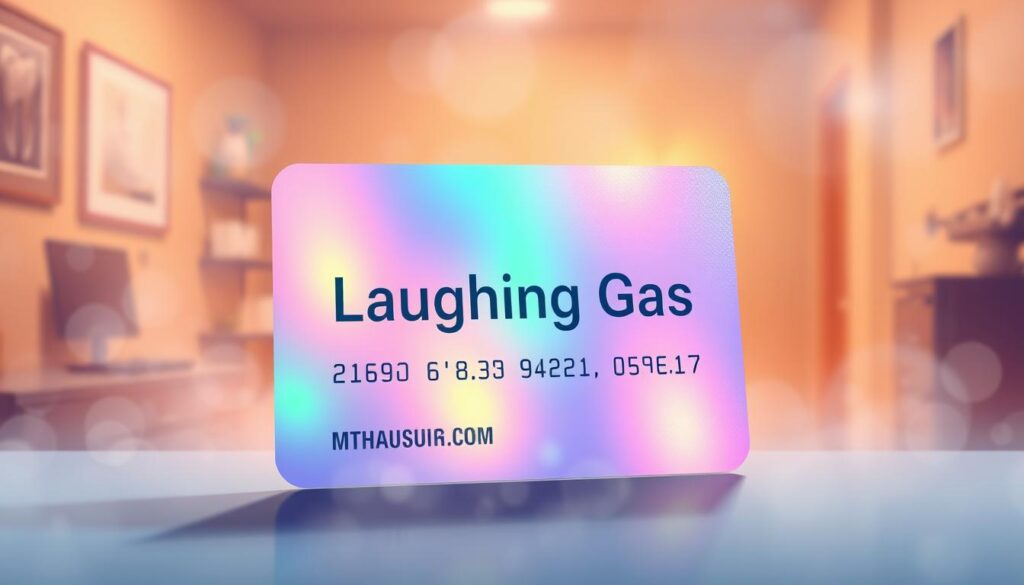
It’s key to know the differences in insurance plans when it comes to laughing gas. High PPO (Preferred Provider Organization) Plans and HMO (Health Maintenance Organization) Plans have different ways of covering laughing gas.
High PPO Plans vs. HMO Plans
High PPO Plans give more freedom in choosing providers and cover more services, including laughing gas. PPO Plans might pay more, but you still might have to pay some out-of-pocket.
HMO Plans have a smaller network but often cost less. They might have stricter rules for laughing gas coverage. You might need to get approval before using it.
Deductibles, Co-pays, and Out-of-pocket Costs
Knowing about deductibles, co-pays, and out-of-pocket costs is crucial. The cost of laughing gas copay can differ a lot between plans.
A deductible is what you pay before insurance kicks in. For example, if your deductible is $500, you pay the first $500 of dental costs, including laughing gas.
“The key to managing dental care costs, including laughing gas, is understanding your insurance plan’s specifics,” says a dental insurance expert. “Patients should review their policy details to anticipate their expenses accurately.”
After the deductible, you pay a co-pay or coinsurance for laughing gas. A co-pay is a fixed amount, and coinsurance is a percentage. For instance, if the copay is $50, you pay $50 each time. If insurance covers 80%, you pay 20% as coinsurance.
Out-of-pocket costs can add up. Knowing these costs helps plan for dental care, including laughing gas.
Getting an Estimate from Your Dentist
Understanding the costs of dental procedures with laughing gas is important. Patients should ask about the expenses of their treatment.
What to Ask Your Dentist
To get an accurate estimate, ask your dentist several key questions. These include:
- What is the total cost of the laughing gas sedation?
- Is laughing gas included in the overall procedure cost or billed separately?
- Are there any additional fees associated with the sedation?
By asking these questions, patients can understand their financial obligations better.
Understanding the Breakdown of Costs
The cost of laughing gas depends on several factors. These include the type of dental procedure, sedation duration, and dentist’s fees. A detailed breakdown helps patients understand where their money goes.
For example, a dentist might charge extra for laughing gas sedation. This could be in addition to the procedure cost. Knowing these costs helps patients make informed decisions about their care.
| Service | Cost Range | Factors Affecting Cost |
|---|---|---|
| Laughing Gas Sedation | $50-$200 | Procedure type, sedation duration |
| Dental Procedure | $100-$500 | Complexity, materials used |
| Total Cost | $150-$700 | Combination of sedation and procedure costs |
Importance of Transparency in Pricing
Transparency in dental pricing builds trust between dentists and patients. When patients understand costs, they feel more comfortable with their treatment plan.
Dentists who provide detailed estimates and explain cost factors show they value transparency. This openness leads to better patient satisfaction and financial planning.
Clear communication about costs is key to a positive dental experience.
Regional Differences in Laughing Gas Costs
Laughing gas prices vary across the country. They change from state to state and even within cities and towns. Knowing these differences helps patients plan their dental expenses.
Cost Variations by State
Laughing gas prices change a lot from one state to another. This is because of things like local dental costs, rules, and living costs. For example, places like California and New York, where living is expensive, often have pricier dental care, including laughing gas.
| State | Average Cost Range of Laughing Gas |
|---|---|
| California | $50-$150 |
| New York | $60-$180 |
| Texas | $40-$120 |
| Florida | $45-$130 |
Urban vs. Rural Pricing
Prices for laughing gas also vary between cities and countryside. Cities usually have higher dental costs because of higher practice costs, like rent and staff pay. But, rural areas might have lower costs, even though dental services might be harder to find.
Key factors influencing urban vs. rural pricing include:
- Cost of living and running a dental practice
- Availability of dental services
- Demand for sedation dentistry
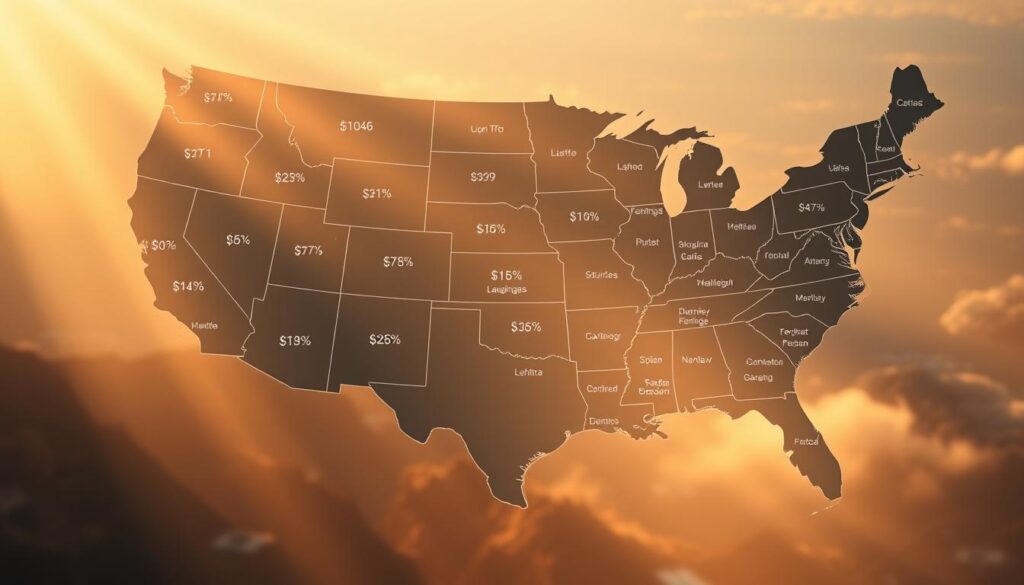
Understanding these regional differences helps patients manage the costs of laughing gas for dental care.
Payment Plans and Financing Options
Managing the cost of laughing gas for dental procedures is easier with the right financing. Many dental care providers offer solutions to help with unexpected expenses. They understand the financial stress these costs can cause.
Flexible Payment Plans Offered by Dentists
Dentists provide flexible payment plans for dental procedures, including those with laughing gas. These plans help by breaking down the cost into smaller monthly payments. This makes it easier to manage the financial burden.
Key benefits of flexible payment plans include:
- Spreading the cost over several months or years
- Avoiding large upfront payments
- Potential for zero or low-interest rates
It’s important for patients to talk about their financial situation with their dentist. This way, they can find a payment plan that fits their budget and needs. Dentists can help tailor a plan that works for each patient.
Using Health Savings Accounts (HSAs)
Patients with Health Savings Accounts (HSAs) can use these funds for dental expenses, including laughing gas procedures. HSAs are a tax-advantaged way to save for medical and dental costs.
Benefits of using HSAs for dental expenses:
- Tax-free growth and withdrawals for qualified medical expenses
- Flexibility to use funds for a wide range of dental procedures
- Ability to carry over unused funds from year to year
Patients should check with their HSA provider if laughing gas for dental procedures is covered. It’s also important to know the contribution limits and any penalties for non-qualified withdrawals.
Alternatives to Laughing Gas
Laughing gas is a well-known choice for sedation in dentistry. But, there are other effective options. People have different needs and preferences when it comes to feeling calm during dental visits.
Local Anesthetics
Local anesthetics are a common alternative to laughing gas. They numb the area where the dental work is done. This is great for those worried about pain, but not the procedure itself.
Numbing agents like lidocaine are often used in dental offices. They work well for procedures that don’t need sedation but do require pain control.
Oral Sedation Options
Oral sedation involves taking medication before a dental visit to relax. The level of relaxation can vary, depending on the medication and how much is taken.
- Triazolam is a medication used for oral sedation. It helps patients feel calm and relaxed.
- Lorazepam is another option. It’s known for its sedative effects.
Other Sedation Techniques
There are more sedation options beyond laughing gas, local anesthetics, and oral sedation. These include:
- IV Sedation: Given through an IV, this sedation allows for a controlled level of relaxation.
- Nitrous Oxide Sedation Alternatives: While laughing gas is a form of nitrous oxide sedation, other ways to use nitrous oxide exist. Other gases might also be used in some cases.
Each alternative has its own benefits. They are suited for different dental procedures and patient needs.
Pediatric Considerations for Laughing Gas
Many parents are curious about using laughing gas in children’s dentistry. They want to make sure their kids are comfortable and safe during dental visits. Laughing gas, or nitrous oxide, is often used in pediatric dentistry to help kids relax during dental procedures.
Safety of Laughing Gas for Children
Parents worry about the safety of laughing gas for their kids. Nitrous oxide is safe when a trained dentist administers it. It has a long history of safety and helps kids feel calm and less anxious during dental visits.
Some benefits of laughing gas in pediatric dentistry include:
- Quick onset and recovery
- Effective in reducing anxiety
- Can be adjusted to the child’s needs
- Safe when used properly
Insurance Coverage for Child Sedation
It’s important for parents to know how insurance handles child sedation. Many dental insurance plans cover laughing gas for kids, especially for complex procedures. But, coverage can differ a lot between insurance providers and policies.
Parents should check their insurance policy for pediatric dental sedation coverage. Key points to look at include:
- The specific sedation methods covered
- Any limitations or exclusions
- Co-payments or deductibles associated with sedation
By understanding these details, parents can plan better for their child’s dental care. They can ensure their child gets the sedation needed for a comfortable dental experience.
Patient Experiences with Laughing Gas
Many patients have shared their positive experiences with laughing gas. They say it helps a lot with anxiety during dental treatments. Laughing gas, or nitrous oxide, has been used in dental offices for years. It’s a safe and effective way to calm patients.

Testimonials from Patients
Patients who have used laughing gas often feel more relaxed and comfortable. For example, a patient might say, “I was nervous about my root canal, but with laughing gas, I felt at ease the entire time.” This kind of positive feedback is common among those who have tried laughing gas for dental care.
Some patients have even said they were able to get through procedures they thought were too scary or painful. This is a big plus, as it lets patients get the dental care they need without fear.
What to Expect During the Procedure
When laughing gas is used, patients usually feel calm and relaxed. The gas is inhaled through a mask over the nose, and its effects are quick. Patients stay awake and can talk to their dentist during the procedure.
The dentist will keep an eye on how comfortable the patient is and adjust the gas as needed. Most patients feel a pleasant, tingling sensation and feel well overall. After the procedure, the gas is turned off, and patients can breathe normally to recover quickly.
Laughing gas is a popular choice for many because it’s good at managing anxiety and discomfort. Knowing what to expect can help patients feel more ready and confident about their dental care.
Preparing for Your Dental Visit
Getting ready for a dental visit involves several steps. These steps can make your experience smoother and less stressful. Whether you’re getting laughing gas or another dental procedure, being prepared is crucial for a successful visit.
Pre-treatment Tips
To make sure you’re ready for your dental visit, consider these tips:
- Arrive Early: Plan to arrive at least 15 minutes before your appointment. This allows time to fill out any necessary paperwork.
- Follow Pre-procedure Instructions: If your dentist gives specific instructions, like fasting or avoiding certain medications, make sure to follow them.
- Disclose Medical History: Tell your dentist about any changes in your medical history, including new medications or health conditions.
What to Bring and Questions to Ask
Being prepared with the right information and questions can greatly impact your dental visit. Here are some essentials to consider:
- Insurance Information: Bring your insurance cards and any relevant documentation. This ensures your coverage is processed correctly.
- List of Medications: Provide your dentist with a current list of medications you’re taking, including dosages.
- Questions for Your Dentist: Prepare a list of questions to ask. This can include procedure details, expected outcomes, and post-procedure care instructions.
By being prepared and informed, you can reduce your anxiety. This ensures a more positive experience during your dental visit.
FAQs About Laughing Gas Costs
Many patients wonder about the costs of laughing gas and how insurance affects it. Laughing gas, or nitrous oxide, is a common sedation in dentistry. Knowing its costs helps patients make better choices for their care.
Commonly Asked Questions
Patients often ask about laughing gas’s cost, effectiveness, and safety. Here are some answers to common questions:
- Is laughing gas expensive? Costs vary by dental practice, location, and procedure.
- Does insurance cover laughing gas? Coverage depends on the insurance provider and policy.
- How long does laughing gas last? Its effects last a few minutes after the procedure.
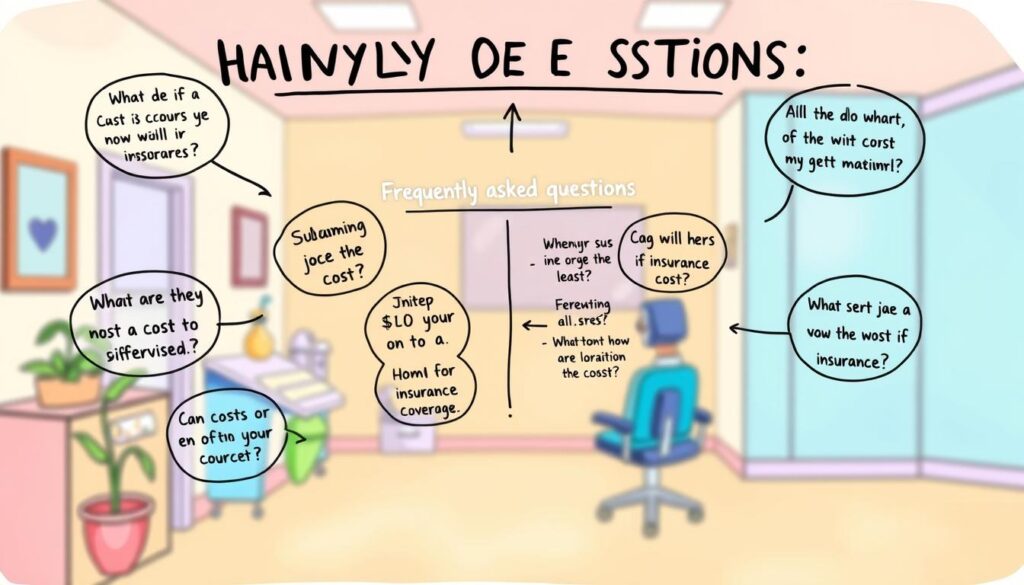
Clarifications About Insurance Claims
Understanding insurance claims for laughing gas can be tricky. Here are some important points:
| Insurance Type | Coverage Level | Out-of-Pocket Costs |
|---|---|---|
| PPO Plans | Typically covers 50-80% | $20-$100 |
| HMO Plans | Varies by plan | $10-$50 copay |
It’s crucial to check your insurance policy and talk to your dentist. This way, you’ll understand the costs of laughing gas and how they’ll be covered.
The Role of the Dentist in Cost Management
Dentists are more than just healthcare providers. They guide patients through the financial side of dental care, including laughing gas costs.
Managing dental care costs is a team effort between the patient and dentist. The dentist’s office can explain the costs of different treatments. They also help patients understand their insurance.
How Dentists Can Help with Insurance Navigations
Dentists and their staff are key in understanding dental insurance. They help patients know what their plan covers, including laughing gas.
Here are some ways dentists can help with insurance navigation:
- Verifying insurance coverage before procedures
- Explaining the breakdown of costs for treatments
- Assisting with paperwork and claims
By working with their dentist, patients can understand their financial responsibilities. This helps them make informed decisions about their care.
Communicating Effectively With Your Dental Office
Clear communication is crucial for managing costs. Patients should ask questions about their treatment plans and costs.
| Communication Tips | Benefits |
|---|---|
| Ask about costs upfront | Avoids surprise bills |
| Discuss insurance coverage | Clarifies out-of-pocket expenses |
| Inquire about payment plans | Provides financial flexibility |
Open communication helps patients and dentists find cost-effective solutions. This meets the patient’s needs.
The Future of Dental Sedation Anesthesia
Dental technology is getting better, changing how we care for patients. New sedation methods are making dental visits easier and more comfortable. This means more people can get the dental care they need.
Innovations in Sedation Techniques
New ways to make dental visits comfortable and safe are being developed. Conscious sedation and minimal sedation are becoming popular. They help patients relax without losing consciousness.
- New ways to use nitrous oxide are being explored, making it safer and more effective.
- There are now more options for oral sedation, helping patients manage their anxiety.
Research into transdermal sedation is also underway.
Insurance Trends Affecting Sedation Options
Insurance changes are also impacting dental sedation. Dental insurance plans are getting better, covering more sedation options.
“The trend towards more inclusive dental insurance plans is a positive development for patients who require sedation during dental procedures.”
Some key trends include:
- Premium insurance plans now cover more sedation dentistry.
- There are more flexible payment options for sedation.
- More people see how sedation improves dental care results.
As dental care evolves, it’s important to keep up with sedation and insurance news. This helps patients make better choices and dentists provide top care.
Conclusion: Making Informed Choices
It’s important to know the costs of laughing gas and how insurance works. This knowledge helps you make smart choices about your dental care. You now understand what affects the cost of laughing gas, like insurance, location, and other sedation options.
Key Takeaways
Laughing gas costs can change a lot based on where you are, who your dentist is, and your insurance. Always talk to your dentist to get a clear price and know what your insurance pays for.
Preparing for Your Appointment
Before your dental visit, check your insurance policy to see what’s covered. Talk to your dentist about sedation options, like laughing gas, and any extra costs. Being ready will make your visit easier and less stressful.
FAQ
How much is laughing gas at the dentist with insurance?
FAQ
How much is laughing gas at the dentist with insurance?
The cost of laughing gas with insurance changes based on your insurance, the dentist, and the procedure. On average, you might pay
FAQ
How much is laughing gas at the dentist with insurance?
The cost of laughing gas with insurance changes based on your insurance, the dentist, and the procedure. On average, you might pay $0 to $200 out-of-pocket, depending on your insurance.
Does insurance cover laughing gas?
Many dental insurance plans do cover laughing gas. But, how much they cover can vary. Some plans might cover it fully, while others might ask for a co-pay or have limits on use.
What is the laughing gas cost with insurance?
The cost of laughing gas with insurance can be fully covered or a partial expense. It’s best to check your insurance policy to know the exact costs and coverage.
How do I know if my insurance covers laughing gas?
To find out if your insurance covers laughing gas, look at your policy or call your insurance. Ask about any deductibles, co-pays, or use limits.
Can I use my Health Savings Account (HSA) for laughing gas?
Yes, you can use your HSA for laughing gas. It’s considered a qualified medical expense. Just check with your HSA provider about their policies and any needed documents.
Are there any additional costs associated with laughing gas?
Besides the cost of laughing gas, you might also pay for the dental procedure itself. This includes the dentist’s fee, facility fees, and any follow-up care.
How can I minimize my out-of-pocket costs for laughing gas?
To lower your costs, choose an in-network dentist and understand your insurance. Also, ask about payment plans or financing options.
Is laughing gas more expensive than other sedation options?
Laughing gas costs can vary compared to other sedation options. It’s generally affordable, but prices can change based on the procedure, location, and dentist.
Can my dentist help me understand the costs and insurance coverage for laughing gas?
Yes, your dentist and staff can explain the costs of laughing gas. They can also help with insurance and claims.
What should I ask my dentist about laughing gas costs and insurance?
Ask your dentist about the total procedure cost, insurance coverage, and any out-of-pocket expenses. Also, ask about any extra fees for laughing gas.
to 0 out-of-pocket, depending on your insurance.
Does insurance cover laughing gas?
Many dental insurance plans do cover laughing gas. But, how much they cover can vary. Some plans might cover it fully, while others might ask for a co-pay or have limits on use.
What is the laughing gas cost with insurance?
The cost of laughing gas with insurance can be fully covered or a partial expense. It’s best to check your insurance policy to know the exact costs and coverage.
How do I know if my insurance covers laughing gas?
To find out if your insurance covers laughing gas, look at your policy or call your insurance. Ask about any deductibles, co-pays, or use limits.
Can I use my Health Savings Account (HSA) for laughing gas?
Yes, you can use your HSA for laughing gas. It’s considered a qualified medical expense. Just check with your HSA provider about their policies and any needed documents.
Are there any additional costs associated with laughing gas?
Besides the cost of laughing gas, you might also pay for the dental procedure itself. This includes the dentist’s fee, facility fees, and any follow-up care.
How can I minimize my out-of-pocket costs for laughing gas?
To lower your costs, choose an in-network dentist and understand your insurance. Also, ask about payment plans or financing options.
Is laughing gas more expensive than other sedation options?
Laughing gas costs can vary compared to other sedation options. It’s generally affordable, but prices can change based on the procedure, location, and dentist.
Can my dentist help me understand the costs and insurance coverage for laughing gas?
Yes, your dentist and staff can explain the costs of laughing gas. They can also help with insurance and claims.
What should I ask my dentist about laughing gas costs and insurance?
Ask your dentist about the total procedure cost, insurance coverage, and any out-of-pocket expenses. Also, ask about any extra fees for laughing gas.

